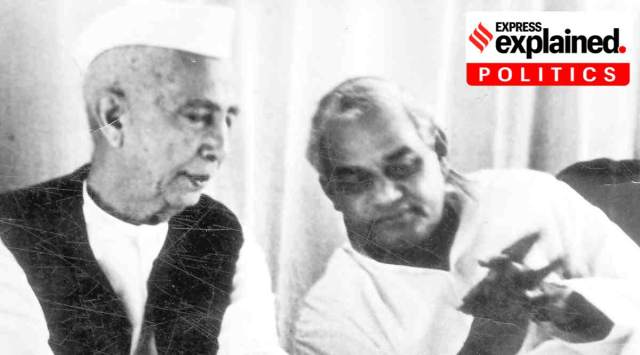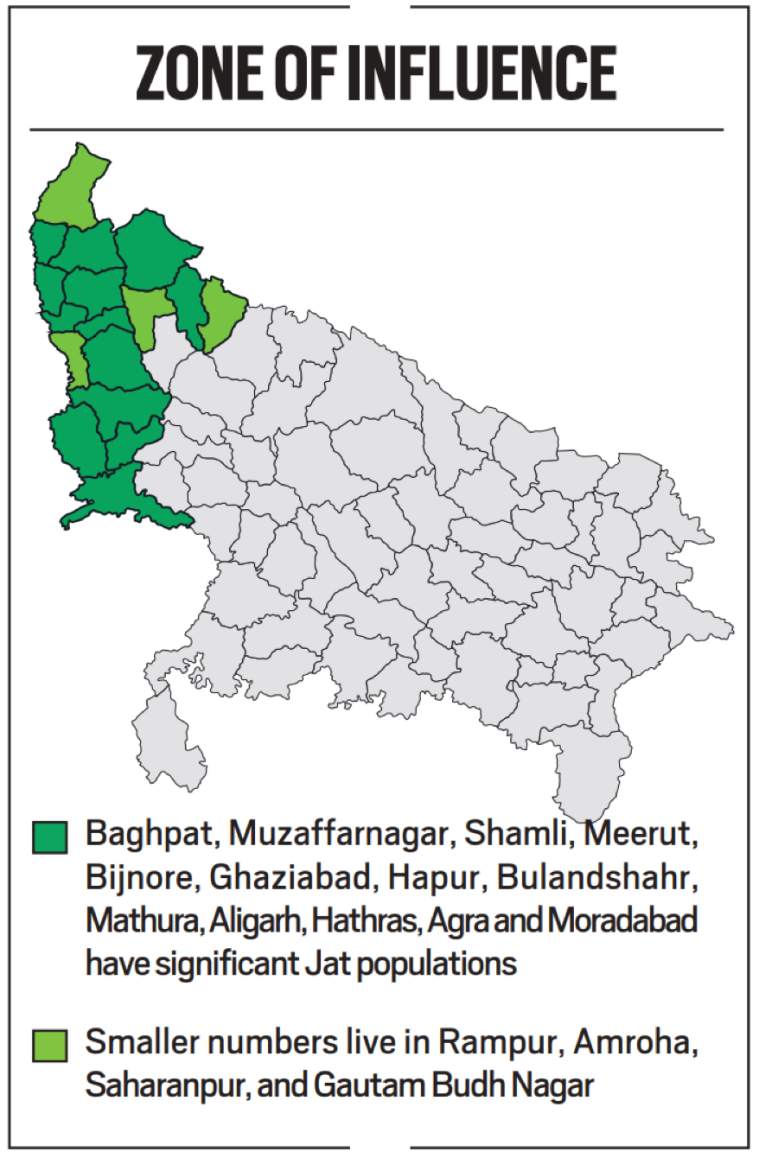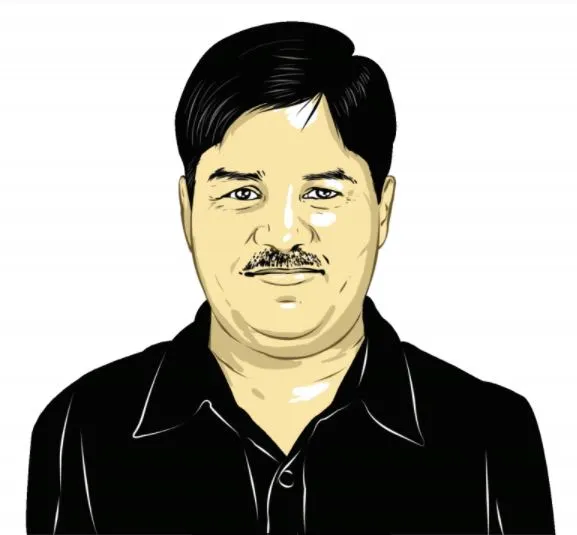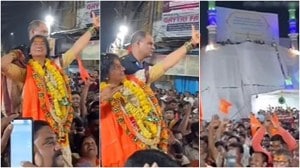- India
- International
Explained: Jats and the BJP in Uttar Pradesh
🔴 What is the history and politics of — and around — the Jat community of Western Uttar Pradesh? Who have been their leaders, how have they voted, and why is this history important in the coming Assembly elections?
 Charan Singh with Atal Bihari Vajpayee in 1983. (Express Archive)
Charan Singh with Atal Bihari Vajpayee in 1983. (Express Archive)Home Minister Amit Shah’s outreach to Jayant Chaudhary — which the RLD leader rebuffed saying he was not a 25-paisa coin that would flip — indicated the importance that the BJP attaches to Jats and their main political platform in Western Uttar Pradesh.
The RLD and its partner, the Samajwadi Party (SP), are trying hard to win back this part of the state where the BJP has done well in recent elections. When the Centre withdrew the three farm laws in November, it had its eyes more on Western UP than on Punjab or other parts of the country.
Who are the Jats?
The census of 1891 recorded 1,791 different communities of Jats, and K S Singh, editor of the People of India series, noted “there are Hindu, Muslim and Sikh Jat”, and “these divisions regulate their marriage alliances”. Jats are a predominantly farming community who are mostly concentrated in Haryana, UP, Delhi, and Rajasthan today.
Jats want to be included among the Other Backward Classes (OBCs) in the central list. In states such as UP, Rajasthan, Delhi, Himachal Pradesh, and Madhya Pradesh, they are already categorised as OBC. Jats of Rajasthan — except those in Dholpur and Bharatpur — are also OBC in the central list.
Jats are a politically powerful community, and can influence the results of nearly 40 Lok Sabha seats and around 160 Assembly seats in UP, Haryana, Rajasthan, and Delhi. In UP, they are concentrated in the western districts, mainly cultivate sugarcane, and are the state’s richest farming community.

 Zone of influence
Zone of influence
Who have been their prominent leaders ?
In the 1950s and 60s, Devi Lal and Ranbir Singh Hooda (father of former Haryana Chief Minister Bhupinder Singh Hooda) were prominent Jat leaders of (undivided) Punjab. In Rajasthan, there was Nathuram Mirdha, and in UP, Chaudhary Charan Singh.
After the creation of Haryana in 1966, leaders such as Bansi Lal emerged. Jats are more than 25 per cent in Haryana, and have long dominated its politics.
Until his demise in 1987, Charan Singh remained among the tallest Jat leaders of the country, who had a following among other castes too. He was Chief Minister of UP twice, Deputy Prime Minister and, for a little less than six months in 1979-80, Prime Minister.
In UP, Charan Singh led the farmer communities away from both the Congress and Bharatiya Jana Sangh, precursor of the BJP, which had a large number of MLAs from these communities after the elections of 1967.
Charan Singh’s political legacy was inherited by his son Ajit Singh, but the arrival of Mandal and Hindutva fundamentally changed politics in UP — and the Jats under Ajit Singh made several adjustments to remain relevant over the next quarter century.
Where is the Jat vote in UP?
The community has significant influence in a dozen Lok Sabha and around 40 Assembly seats in Western UP. They are estimated to comprise between 10 and 15 per cent of the population in some 15 districts, but are socially dominant, vocal, and have the capacity to build a political atmosphere.
Baghpat, Muzaffarnagar, Shamli, Meerut, Bijnore, Ghaziabad, Hapur, Bulandshahr, Mathura, Aligarh, Hathras, Agra and Moradabad have significant Jat populations. Smaller numbers live in Rampur, Amroha, Saharanpur, and Gautam Budh Nagar.
Jats in UP have by and large thrown their lot with the ruling party. The political base created by Charan Singh was harnessed by Mulayam Singh Yadav, and a large section of Jats switched to the BJP during the last decade.
In the Assembly elections of 2022, 58 seats in the districts of Muzaffarnagar, Shamli, Meerut, Ghaziabad, Hapur, Baghpat, Bulandshahr, Gautam Budh Nagar, Aligarh, Mathura, and Agra will vote on February 10 in the first phase.
In the second phase on February 14, 55 seats will go to polls, spread over the districts of Bijnore, Moradabad, Sambhal, Rampur, Amroha, Bareilly, Badayun, and Shahjahanpur.
The bulk of the seats going to polls in these two phases are Jat dominated.
What was Ajit Singh’s political career like?
Chaudhary Ajit Singh, the IIT-educated son of Charan Singh, switched sides frequently to remain relevant in national and UP politics.
He joined V P Singh’s government, but defected to the Congress in 1995 and joined P V Narasimha Rao’s government. In the Lok Sabha election of 1996, he won from Baghpat as a Congress candidate, but resigned from Parliament the following year and formed his own Bharatiya Kisan Kamgar Party (BKKP). In the Lok Sabha election of 1998, Ajit Singh lost his traditional Baghpat seat.
In 1999, he formed the Rashtriya Lok Dal (RLD) which won two seats in the Lok Sabha election of that year — Baghpat and adjoining Kairana. It retained these seats in 2004. Ajit Singh had been part of Atal Bihari Vajpayee’s ministry, and he tried to join the Manmohan Singh government, but that did not materialise for several years.
The RLD went back to an alliance with the BJP in 2009, contested nine seats, and won five. But in 2011, Ajit Singh joined the ministry of Prime Minister Manmohan Singh. The next two Lok Sabha elections were disastrous for the RLD, and both Ajit Singh and his son Jayant Chaudhary lost. Ajit Singh passed away from Covid-19 last year.
How did the Jats do in UP in the Mandal-kamandal years?
The BKKP was Ajit Singh’s ninth political switch. In the UP elections of 1996, he sought the support of farmer leader Mahendra Singh Tikait, and entered into a seat adjustment with Mulayam Singh’s SP. He contested 38 seats but won just eight.
The RLD fought the 2002 elections in alliance with the BJP, and won 14 of the 38 seats it contested. It joined the BJP-BSP government headed by Mayawati, but the RLD’s alliance with the BJP broke soon afterward.
When Mulayam Singh took oath in 2003, Ajit Singh’s MLAs joined the government. But again, only a few months before the UP elections of 2007, the RLD pulled out of Mulayam’s government.
Post 2007, the RLD steadily lost relevance as voters of UP gave clear mandates — to the BSP in 2007, SP in 2012, and BJP in 2017. In the BSP wave of 2007, the RLD contested 254 seats and won only 10. In 2012, when Ajit Singh was Union Civil Aviation Minister, the RLD fought with the Congress, and won just nine seats.
How has the BJP done among Jat voters?
The alliance with the RLD never helped the BJP. It was always understood that the BJP transferred its votes to RLD candidates, but the reverse did not happen.
The ‘new’ BJP of Narendra Modi and Amit Shah decided not to have an alliance with RLD, but instead field its own Jat candidates. The communal riots in Muzaffarnagar in 2013 led to a strong polarisation, and boosted the Modi wave in the Lok Sabha elections of 2014.
 In the 2017 Assembly elections, the BJP won 73 of the 94 seats in the 17 districts of Western UP. The SP won 15, BSP three, Congress two, and RLD, the party of the Jats, won just one seat.
In the 2017 Assembly elections, the BJP won 73 of the 94 seats in the 17 districts of Western UP. The SP won 15, BSP three, Congress two, and RLD, the party of the Jats, won just one seat.
Among the farmer communities, Yadavs are considered to be anti-BJP, and an SP votebank. The Kurmis are thought to vote for candidates from their community, cutting across party lines. The other big chunk of OBCs — Maurya-Shakya-Saini-Kushwaha — voted solidly for the BJP in 2014, 2017, and 2019, but the recent exodus of powerful leaders from this group has come as a blow for the party.
The Muzaffarnagar violence finally broke the old alliance of Jats and Muslims forged by Charan Singh. However, Jats had been gradually moving closer to the BJP’s Brahmin-Bania-Thakur combination for several years prior to that break. The traditional influence of the Arya Samaj over the community was a factor in this.
After V P Singh implemented the Mandal Commission report to counter his powerful Deputy Prime Minister Devi Lal, the Jats were annoyed. Over the years, the distance between the Jats and other farming communities, who were categorised as OBC, increased.
What is the state of play ahead of the elections that begin on February 10?
In 2017, the BJP fielded 15 Jat candidates; 14 won. This time, the party has fielded 17 candidates from the community. The RLD has fielded 12 Jat candidates, and the SP six.
There is anger in the community over the now withdrawn farm laws; issues like the payment of sugarcane dues also have some traction.
For Akhilesh-Jayant, the coming back together of Jat and Muslim voters is crucial; the BJP, on the other hand, is trying its best to polarise the election along Hindu-Muslim lines.
Newsletter | Click to get the day’s best explainers in your inbox
More Explained
EXPRESS OPINION
Apr 18: Latest News
- 01
- 02
- 03
- 04
- 05









































